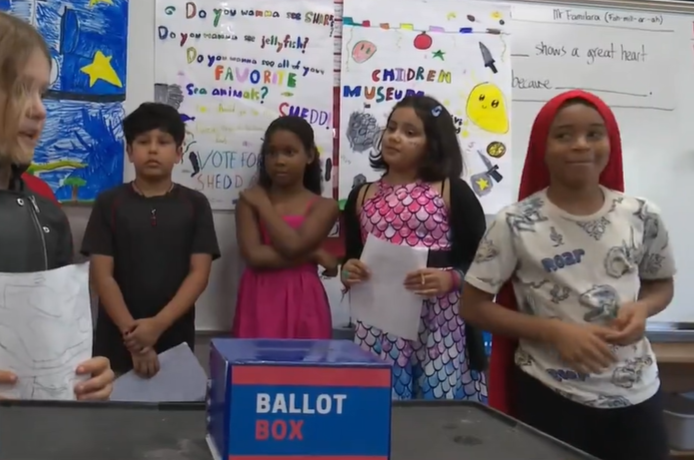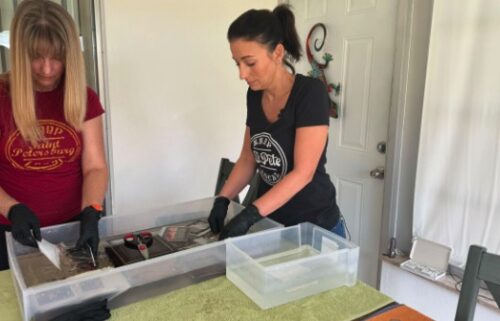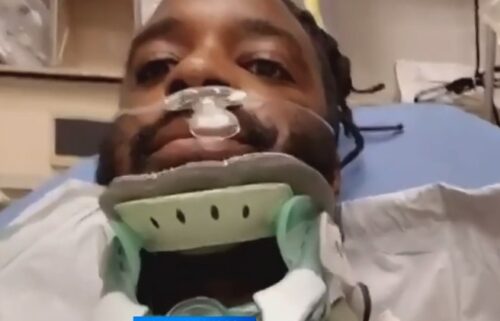Fourth graders get a valuable early lesson in voting

Fourth graders at Lincoln Elementary in Evanston
By Marie Saavedra, Edie Kasten
Click here for updates on this story
EVANSTON, Illinois (WBBM) — At Lincoln Elementary School in north suburban Evanston, some fourth graders may have lessons for us all.
The young voters—for an in-class poll—were very excited to learn about the process firsthand. Their teacher set it all up in a most creative way too.
“I really learned a lot from this that I did not know before,” one boy in the class said.
The fourth graders won’t be old enough to vote in an actual election for quite a few years yet, but this vote in class was more than important enough to them.
“It’s important to inform what we’re going to decide in who to vote for, and educate ourselves so that we know that our vote really does count and really does matter,” said teacher Kevin Familara.
Mr. Familara was pleased to plan the lesson in democracy.
“Being a voter myself, I wanted to go through the process of voting and what you really need to do to vote,” he said.
But instead of candidates, the youngsters at Lincoln Elementary—located at 910 Forest Ave. at Main Street not far from Lake Michigan—voted on something more-kid friendly. The class voted on their favorite museum in Chicago—electing one “president.”
There were several days of research, making campaign signs, and crafting the perfect pitches to voters.
Groups of kids campaigned for each museum—the Chicago Children’s Museum, the Griffin Museum of Science and Industry, the Shedd Aquarium, the Field Museum of Natural History.
At the Chicago Children’s Museum at Navy Pier, one boy said in an enthusiastic campaign speech: “The castle exhibit has everything—a king, a queen, and you can also build our own sword.”
“There are animals such as sea otters, beluga whales, California sea lions, and finally Pacific white-sided dolphins,” fourth grader Josie Thomas said in campaigning for the Shedd.
After some reflection, it was time to fill the ballot box. Mr. Familara made sure the kids took the process seriously just like real voters would.
“Make sure that you and only you can see who you’re voting for,” he told them.
Mr. Familara even gave the kids buttons for their shirts to show they had voted—much like the stickers adults receive after turning in their ballots.
Before counting the ballots, the kids themselves emphasized how much of an impact this exercise made.
“I learned that like voting is really, really important, because without a president life would be chaos,” said Aarna Sharma.
They also learned how to pick the issues to get voters on their side.
“You want to put like the ones you know the most people talk about and most people like, because then most of the people will vote for you,” said Josie.
Evaluating campaign speeches and other information was also a lesson they took in.
“The Children’s Museum did have a great speech, so I was considering voting for them, but like the, Field Museum was unstoppable,” said Gus Tingley.
But mostly, the takeaway was the big meaning behind each ballot.
“Even though you don’t think your voice will be heard, it will,” said Jenley Rah. “Every vote is like, helping history.”
So back to the history at hand. As Mr. Familara tallied, there was polite applause across party lines for what ended up being a razor thin race.
The winner was the Shedd Aquarium—beating out the Chicago Children’s Museum by one vote. When Mr. Familiara announced the winner, the kids began shrieking and jumping for joy.
It’s such enthusiasm that can make elections great.
“It’s so important to me to get them involved in wanting to learn, you know, something that is their civic duty when they come of age,” Mr. Familara said.
Mr. Familara told the class, “All of these things matter because they directly affect you.”
Mr. Familara also said the students are learning another important lesson—how to disagree respectfully. It’s something the grown-ups could keep in mind too.
Many of the fourth graders will cast their first vote for U.S. president in 2036. That is not as far off a year as it may seem like—it is eight years from now.
Please note: This content carries a strict local market embargo. If you share the same market as the contributor of this article, you may not use it on any platform.


